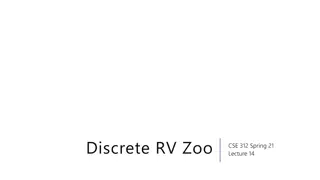Understanding Random Assignment in Experiments
Explore the importance of random assignment in conducting experiments effectively. Learn how to assign treatments randomly using methods like slips of paper or technology, ensuring equivalent groups and minimizing confounding variables. Discover the significance of random assignment in maintaining reliability and validity in experimental studies.
Download Presentation

Please find below an Image/Link to download the presentation.
The content on the website is provided AS IS for your information and personal use only. It may not be sold, licensed, or shared on other websites without obtaining consent from the author. Download presentation by click this link. If you encounter any issues during the download, it is possible that the publisher has removed the file from their server.
E N D
Presentation Transcript
Collecting Data Lesson 3.7 How to Experiment Well Statistics and Probability with Applications, 3rdEdition Starnes & Tabor Bedford Freeman Worth Publishers
How to Experiment Well Learning Targets After this lesson, you should be able to: Describe how to randomly assign treatments using slips of paper or technology. Explain the purpose of random assignment in an experiment. Identify other sources of variability in an experiment and explain the benefits of keeping these variables the same for all experimental units. Statistics and Probability with Applications, 3rdEdition 2 2
How to Experiment Well If treatments are given to groups that differ greatly when the experiment begins, confounding is likely. The solution to this problem is random assignment. Random Assignment In an experiment, random assignment means that experimental units are assigned to treatments using a chance process. Random assignment should create groups that are roughly equivalent with respect to every variable that might affect the response. Random assignment works best when there are many subjects in the experiment. The idea that we should use enough subjects to create roughly equivalent groups is sometimes called replication. Statistics and Probability with Applications, 3rdEdition 3 3
Does mint improve your mind? Does mint improve your mind? Random assignment methods Random assignment methods PROBLEM: In Mr. Tyson s class, 30 students volunteer to participate in experiment to determine if chewing mint during a test will increase their score on that test. Mr. Tyson will provide mint gum for half of the students, while the other half will not chew gum. The same test will be given to every student. Describe how you would gum randomly assign students to each treatment: (a) Using identical slips of paper On 15 slips of paper, write the letter A and on the remaining 15 slips write the letter B. Shuffle the slips of paper and hand out one slip of paper to each volunteer. Students who get an A slip will chew mint gum during the test while those who get a B slip will not chew gum. (b) Using a random number generator Label each student with a different integer from 1 to 30. Then, randomly generate 15 different integers from 1 to 30. The students with these labels will chew mint gum during the test. The remaining 15 students will not chew gum. Statistics and Probability with Applications, 3rd Edition 4 4
Should we watch more cartoons? Should we watch more cartoons? The purpose of random assignment The purpose of random assignment PROBLEM: Can watching fast-paced cartoons reduce the mental functioning of children?Sixty 4-year-old children were randomly divided into three groups. One group was shown a fast-paced cartoon, one group was shown an educational cartoon, and one group was given art supplies and instructed to draw pictures. All of the children spent 9 minutes watching the cartoon or drawing. Afterward, the 4-year-olds who watched the fast-paced cartoon scored significantly worse than the other two groups on four different tests that measured brain function. Explain the purpose of the random assignment in the context of this experiment. The purpose of random assignment is to create roughly equivalent groups at the beginning of the experiment. For example, if you let the children choose which show they will watch, it is possible that more girls would choose to draw pictures. Because girls and boys may differ in the rate that their brains develop, we wouldn t know if any difference in brain function was due to gender or the treatment given. Statistics and Probability with Applications, 3rd Edition 5 5
How to Experiment Well Although random assignment should create groups of experimental units that are roughly equivalent at the beginning of an experiment, there are other variables that might have an impact on the response variable. One reason to keep other variables the same for each subject is to prevent confounding. The second reason we keep other variables the same is to reduce the variability in the response variable, making it easier to determine if one treatment is more effective than another. Statistics and Probability with Applications, 3rd Edition 6 6
Botox for back pain? Botox for back pain? Other sources of variability Other sources of variability PROBLEM: Recall the experiment to see if Botox can reduce back pain as described in an alternate example in Lesson 3.6. This experiment randomly assigned patients with back pain to receive 200 units of Botox or the placebo treatment, saline. The decrease in back pain was measured after 8 weeks for each patient. (a) Why was it important to measure each patient 8 weeks after treatment? If patients were measured at differing time intervals, the researchers wouldn t know if type of injection or time was the reason for changes in back pain. (b) Why was it important to give each patient the same dosage of Botox or saline? If patients were allowed to choose the dosage, the change in pain would be much more variable than it would be otherwise, making it harder to tell if the type of injection made a difference. Statistics and Probability with Applications, 3rd Edition 7 7
LESSON APP 3.7 Multitasking? Or multiple distractions? Researchers in Canada performed an experiment with university students to examine the effects of multitasking on student learning. The 40 participants in the study were asked to attend a lecture and take notes with their laptops. Half of the participants were randomly assigned to complete other online tasks not related to the lecture during that time. These tasks were meant to imitate typical student Web browsing during classes. The remaining students simply took notes with their laptops. At the end of the lecture, all participants took a comprehension test to measure how much they learned from it. The results: students who were assigned to multitask did significantly worse (11%) than students who were not assigned to multitask. Statistics and Probability with Applications, 3rd Edition 8 8
LESSON APP 3.7 Multitasking? Or multiple distractions? 1. Describe how the researchers could have carried out the random assignment. Statistics and Probability with Applications, 3rd Edition 9 9
LESSON APP 3.7 Multitasking? Or multiple distractions? 2. Why was it important that the researchers randomly assigned treatments to the students? 3. Identify one variable that the researchers kept the same for all subjects. Provide two reasons why it was important for the researchers to keep this variable the same. Statistics and Probability with Applications, 3rd Edition 10 10
How to Experiment Well Learning Targets After this lesson, you should be able to: Describe how to randomly assign treatments using slips of paper or technology. Explain the purpose of random assignment in an experiment. Identify other sources of variability in an experiment and explain the benefits of keeping these variables the same for all experimental units. Statistics and Probability with Applications, 3rd Edition 11 11























